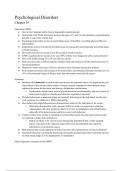Class notes
Psychological Disorders (Chapter 16) - Psychology: Frontiers and Applications
- Course
- PSYCH 1003 (PSYCH1003)
- Institution
- University Of Western Ontario (UWO )
This document covers all essential information in Chapter 16 of the “Psychology: Frontiers and Applications” textbook in a succinct and informative way, and is a suitable substitute for reading the textbook chapter itself for those running short on time or looking for a quick summary. Includes ...
[Show more]



